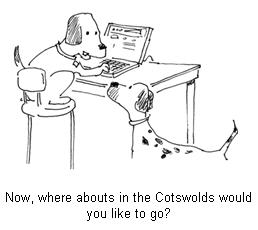 |
| The Local Time is Saturday, 27-Jul-2024 12:43:28 CEST |
About your Dog and
|
|
|||
| YOU ARE HERE: Main Home Page > Dog Friendly Cotswolds > Advice and Training | E-mail This Page |
 |
|
||||||||||
 |
||||||||||
Welcome to Dog Friendly Cotswolds - About your Dog and TrainingCongratulations! You're on your way to having a happy, well-behaved dog. By committing time and energy to your dog's training you have taken the first step in realising that well-behaved dogs are made, not born. Weeks of learning will become years of good manners. Dogs do not know right from wrong, nor can they read your mind. You have to teach your dog what is proper behaviour and what is not. The biggest hurdle is explaining to our dogs what we want. Most of us aren't born knowing how to train dogs, but if you understand at least the following 3 things, you are well on your way:
In short, we will be going through a basic training programme based on how dogs think, how they communicate, and how they learn. Remember, training should be carried out by the whole family (especially kids under supervision) and it should be consistent, so that dog has predictability in its life. Imagine trying to learn a new language when everyone in the house spoke a different one! Above all, have FUN with your dog, that's why you got your dog, right?! Canine CommunicationRemember, dogs cannot read your mind. Many problems arise because the dog simply just does not understand what you want it to do. It is your job to help your dog figure it out. Let's look at some of the things that will influence your dog's behaviour. SmellThis is the dog's primary means of exploring the world. As far as dogs are concerned, the smellier, the better! So what does this mean for training? Well, it means that if you use soft, smelly food to train your dog, he will be motivated by it and perform the behaviour you want it to do. Some examples of excellent titbits include: hotdogs, cheese, liver, sausages, ham, and chicken. Food (smell) allows you to lure your dog into almost any position, without pushing, poking, or prodding at it. Where the nose goes, the dog follows! So for example, you can teach your dog to sit, by holding a titbit no more than ½ and inch above their nose and then moving the food back (not up) toward their tail. The dog will follow the food by raising its head and the rump will go down. Easy! Your dog just sat down without you having to force him to do anything. SightIf you learn anything from this series, then just learn that dogs use visual signals to communicate with each other. Your dog is watching while you are talking. They of course also communicate via sound, but visual signals overwhelm sounds if presented at the same time, So if you ask your dog to sit whilst you are sitting down watching TV and the dog doesn't respond, then it is because you have always taught the dog to sit whilst standing up facing it. The dog has only learnt to sit when you are standing up facing it. This is the most common cause of miscommunication with dogs. The problem is that we aren't usually aware of how our body moves. Our dogs become confused and eventually learn to ignore us. Some visual signals do not need to be taught. Dogs tend to naturally respond to your bending or sitting down as if it were a 'play bow' of a litter mate and come running to play. Standing tall and moving abruptly forward has the opposite effect and the dog will stop in their tracks. Other visual signals need to be taught, but dogs learn them very fast, especially if they are linked with the lure/reward method, as mentioned in the example above. SoundIt's not what you say, it's how you say it! Your voice can have a profound effect on your dog's behaviour. High, squeaky noises are perceived to be excited, friendly and appeasing. Low, growly noises are threatening and inhibiting. So, if you want your dog to come to you and you say 'Rover, come' in a low, loud growl, then it is the perfect way to insure that Rover stays well away from you! You have just told your dog that if he gets near you, you will bite him. Do you blame Rover for staying away? How long or short the word can also be critical; keep most of your verbal cues relatively short, one word is best. Do not have long sentences and conversations with your dog, as you probably lost Rover about the third word in. Verbal correction should be short, abrupt notes, spoken in a low, authoritative voice. You are trying to just startle the dog, not beat the dog with your voice! On the other hand, stimulating, happy signals should be short, rising pitch and rapidly repeated - for example, calling your dog 'pup,pup,pup' whilst clapping your hands or using short, rising whistles will motivate it to come running to you. You can use long, extended words when you want to slow down or soothe the dog. For example 'staaaaay' or 'goooood dog', if you want to keep the dog quiet. Now that you have a basic idea of how dogs communicate, we will start the training programme in the next issue, which will be devoted in training your dog to come on command.
ENJOY YOUR COTSWOLDS HOLIDAY |
||||||||||
| BACK TO TOP | ||||||||||
Dogs Welcome in the Cotswolds |
||||||||||
| This page last modified Monday, 24-Jul-2023 11:24:33 CEST | ||||||||||

